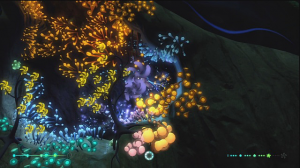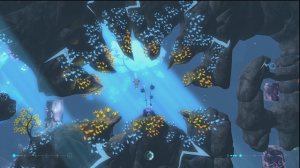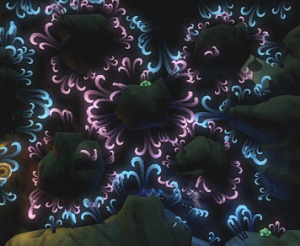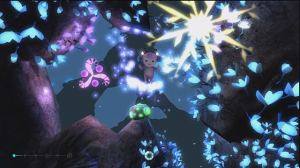Review of The Undergarden
by SealWyf, HSM team writer
There is a place for games like this: the obscure and beautiful, the gentle worldbuilders where just being there gives comfort. Where the challenges are never overwhelming. The games in which you do not continuously die.
In The Undergarden you cannot die, though you may at times be puzzled, and even frustrated. But frustration rarely lasts for long. You soon see what you have to do. If you cannot do it in this session (having already, for instance, spent all of your weight fruit, or bombed shut the entrance to the tunnel) you will plan ahead next time, and accomplish it.
The Undergarden is published by Atari, and is available on various platforms, including the PS3; it can be purchased from the PSN Store. In reviews, the same words tend to be repeated: “gentle”, “puzzler”, “Zen”, “casual”, “physics”. And, invariably, “beautiful”. If I had to write a micro-review of the game, those are the words I would choose. Or, in keeping with its spirit, write the review in haiku:
Flowers blooming under sea:
Beautiful physics.
 And that would tell you all you need to know. But, since we do not review games in haiku, I will explain that The Undergarden is a physics-based puzzler with 20 levels, a side-scroller in which you steer your avatar (a moon-faced baby similar to Teletubbies, though not as annoying) through a maze of underwater caves. You collect pollen from green sponge-cushions, and spend it by leaving a trail of blooming flowers. Making flowers bloom is the emotional heart of the game. As you progress, you paint the world in light.
And that would tell you all you need to know. But, since we do not review games in haiku, I will explain that The Undergarden is a physics-based puzzler with 20 levels, a side-scroller in which you steer your avatar (a moon-faced baby similar to Teletubbies, though not as annoying) through a maze of underwater caves. You collect pollen from green sponge-cushions, and spend it by leaving a trail of blooming flowers. Making flowers bloom is the emotional heart of the game. As you progress, you paint the world in light.
Along the way, there are simple mechanical puzzles to solve: stones to push down or up, wheels to turn, obstacles to shatter. Puzzles are solved with the aid of special fruit, each with a specific action. There are heavy fruit and fruit like foamy helium balloons, lantern fruit to push back the darkness, and electric fruit to complete circuits. There are also bomb fruit, which explode a few seconds after you drop them. At first you scramble to get out of the way, but then you remember that you cannot die. Sitting on top of exploding bombs can be useful, and it’s fun. There are some areas that seem to have no purpose other than the joy of chain-reaction explosions. They’re beautifully rendered, and the physics is well-modeled.
 Along the way, you find special flowers and crystals, and also the enigmatic musicians, dispersed members of a jazz combo who play on regardless of what happens to them. The musicians are one of my favorite elements of the game. Carrying them adds their music to the soundtrack, and makes the surrounding flowers change color. Carrying all the musicians in a level is one of the subgoals, along with blooming all the flowers, and finding the special flowers and crystals. In addition, I have read that gathering musicians in one place will cause things to happen. I haven’t seen it myself, but it’s still amusing to assemble little bands in the middle of the luminous forest, and listen to them play.
Along the way, you find special flowers and crystals, and also the enigmatic musicians, dispersed members of a jazz combo who play on regardless of what happens to them. The musicians are one of my favorite elements of the game. Carrying them adds their music to the soundtrack, and makes the surrounding flowers change color. Carrying all the musicians in a level is one of the subgoals, along with blooming all the flowers, and finding the special flowers and crystals. In addition, I have read that gathering musicians in one place will cause things to happen. I haven’t seen it myself, but it’s still amusing to assemble little bands in the middle of the luminous forest, and listen to them play.
Solving levels unlocks costumes for your avatar — new body colors, horns and various sorts of headgear. Unlocking all the costumes opens new levels. Wearing various items also contributes to trophies. Be sure to check the trophy definitions, since some of the required combinations are obscure.
Among other PS3 games, The Undergarden reminds me most of Flower and PixelJunk Eden. It doesn’t have the Zen purity of Flower; if one were to compare these games to music, Flower would be Mozart, and The Undergarden would be Enya. But there is nothing wrong with Enya — I have a fair amount of her music on my iPod. It puts your mind in a certain state, and it bears repeating. So does this game.
 One of the hints displayed while loading The Undergarden states, “Sometimes it’s fun just to float around.” And indeed it is. You soon get into the gentle looping rhythm of the game, and replay old levels, or circle back through completed areas to admire the scenery. There have been times I have set down the controller and just stared at the screen, amazed at the dark beauty of the world.
One of the hints displayed while loading The Undergarden states, “Sometimes it’s fun just to float around.” And indeed it is. You soon get into the gentle looping rhythm of the game, and replay old levels, or circle back through completed areas to admire the scenery. There have been times I have set down the controller and just stared at the screen, amazed at the dark beauty of the world.
Where is this place? the hint text asks. Why is this place? I gather there are answers, or at least hints of answers, in the final levels.
I’m not there yet. But I’m enjoying the journey.



I love the haiku!
Thanks!
Oh I want this game!! No one dies, love it!!
This is going to sound horribly geeky, but I’ve actually had it in my head to review a Home space or a video game in the style of the Kokinshū (古今集), just because it’s some of my favorite poetry. It’d be a blast, I think.
There’s something to be said for games where there’s no risk of death as a means of upping the tension. Myst, of course, would be an excellent example of this. With only two exceptions, there weren’t really any ways to “die” in that game, and it’s still one of the most engrossing titles I’ve ever played.
I propose setting up a friendly competition among the HSM contributors to review games or Home content in non-traditional ways: in poetry (haiku, tanka, limericks, rhyming couplets, free verse), in other literary forms such as screenplays or comic strips, or forms that are even wilder. Flowcharts, for instance. Concept maps. Or maps such as this one: http://xkcd.com/802/
I will if you will, Norse.
I love it! I *love* it! We need to run with this. At the next production meeting, let’s all figure out which common subject to review, and then anyone who wants to try their hand at a non-conventional format should do so. We’ll compile all the responses into one article and publish it, so that everyone’s included.
Haiku, tanka, limerick, rhyming couplets, iambic tetrameter, free verse, terza rima, sestina, strophic, et cetera…yes.
And Seal, that link you provided gave me *exactly* the template I needed for an idea I’ve been cooking up for the art team. You rock.
How about nonsense verse? :>
We can always use a good guest writer, Johne! Care to channel Edward Lear for us?
Far and few, far and few
Are the savepoints of this game!
You can monster-bash ’til your thumbs are blue
But they’ll get you, just the same.
That…is…awesome, Seal. :>
Thanks!
For those who didn’t recognize the source of the parody, here it is:
http://www.nonsenselit.org/Lear/ns/jumblies.html